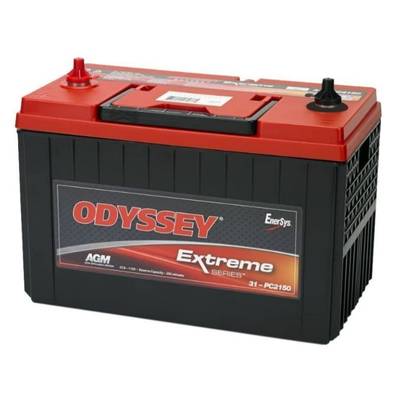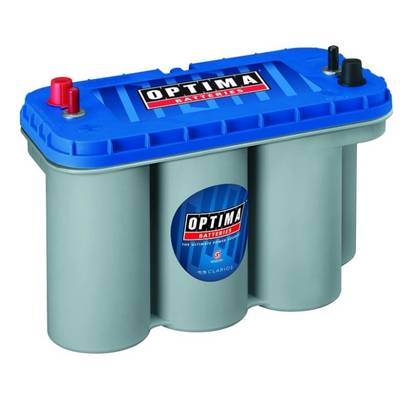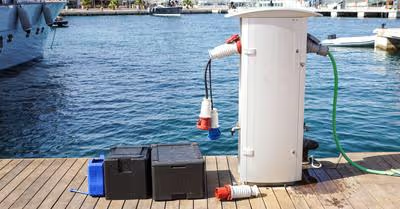
Key Takeaways
- Check the battery terminal connection to ensure they are tight and there is no corrosion.
- When buying marine batteries, you must consider the type, build, cranking amperes, voltage and capacity.
- Compared to flooded cell batteries, AGM batteries are better.
- Marine batteries have a log warranty ranging from 3-5 years.
If you own a boat, you must invest in the best boat cranking battery as it does not only power your engine but all onboard appliances.
The best three boat cranking batteries include Odyssey 31M-PC2150S Heavy Duty Commercial Battery, Optima 34M Blue Top Marine Starting Battery, and Bass Pro Shops X-900 AGM Battery. Although costly, these batteries are best as they offer optimal cranking amperes and are dual-purpose.
We have also researched and reviewed users' opinions and experiences to compile a list of the five best boat cranking batteries you can use in 2022. Read on to learn about factors you should consider before buying a boat cranking battery.
5 Best Boat Cranking Batteries
These are the best boat cranking batteries to use in 2022.
1. Odyssey 31M-PC2150S Heavy Duty Commercial Battery
Odyssey 31M-PC2150S Heavy Duty Commercial Battery
Odyssey 31M-PC2150S is a dual-purpose marine battery that can serve as a deep cycle and cranking battery. It is a powerful battery meant to serve heavy-duty boats and vehicles, including tractors and farming equipment.
We love this marine battery because of its mighty cranking power of 1150, as it helps jumpstart any recreational inboard and outboard engine. And the best part is you can use it during the winter season.
The battery is outfitted with pure lead plates excellent for maximum conductivity and power discharge and protects it against vibrations. It has a powerful cycling capacity which lasts for a maximum of 400 cycles at 80% discharge depth. And delivers about 5 amps per hour, lasting about 20 hours. Thus you can cruise around the lake all day without worrying about recharging.
You don't have to worry about Spillages or corrosion as the battery has an AGM design that makes it spill-proof, and the brass terminals are tin-plated to prevent corrosion.
Although costly, it is the best because of its versatility, as you don't need to buy a separate cranking and deep cycle battery. Thus, saving costs.
Features
- Recharges fast; fully charged within 6 hours
- Operates in warm and cold conditions
- 4-year full-replacement warranty
- Lasts long
- Weight 77.8 lbs
- Has a non-spillage design
- Corrosion resistant
- Measures 13*6.8*9.4 inches
2. Optima 34M Blue Top Marine Starting Battery
Optima 34M Blue Top Marine Starting Battery
This is a popular brand of marine batteries among boat owners as it has vast battery options. It is an excellent starting battery and offers a 12-volt output accompanied by 800 cold cranking amps, which is sufficient to boost any boat's great start. And it can be used in any weather, including winter. It can also be used in vans, including RVS.
The battery design comprises a tightly wound build that keeps the plate intact, thus providing great resistance to vibrations. The batteries are sealed with AGM, which makes them spill-proof, thus requiring minimal maintenance. We love this battery as it's easy to mount and can suit any boat's configuration.
Optima 34M BlueTop Marine Starting Battery is best suited for owners who do not use their boats frequently. We love this marine battery as it has a super-low power discharge rate and can last a whole year, provided it is stored at room temperature. The only downside is that it's expensive.
Features
- Weighs 36.4 lbs
- 100 minutes reserve capacity
- Versatile as it can be used on boats and vehicles
- Low to no maintainance requirements
- 800 cold cranking Amps
- 12 volts
- 3-year warranty
- Measures 6.88*10*7.8 inches
3. Bass Pro Shops X-900 AGM Battery
Bass Pro Shops X-900 AGM Battery is ideal for large boats that need extra cranking power. It is a dual-purpose battery suitable for deep cycling your trolling engine and other electric appliances on your boat. The battery has a CCA of 1150 amps in cold seasons and can go up to 1370 amps in warm seasons. Bass Pro Shops X-900 AGM battery has a 220-minute reserve capacity, which ensures that you can stay out in the water exploring for a long time without worrying about your battery dying.
The battery design makes it resistant to vibration and keeps it steady in rough water conditions. The battery can last for an entire year without recharging, provided you dont use it frequently and store it under room temperature.
Features
- Reinforced with a plastic exterior
- Free replacement in one year and a 3-year warranty
- Weight 65 lbs
- Measuring 6.77*9.78*13 inches
- Impact resistant
- Dual purpose (deep cycle and cranking)
4. Odyssey 31M-PC2150ST-M Trolling Thunder Marine Dual Purpose Battery
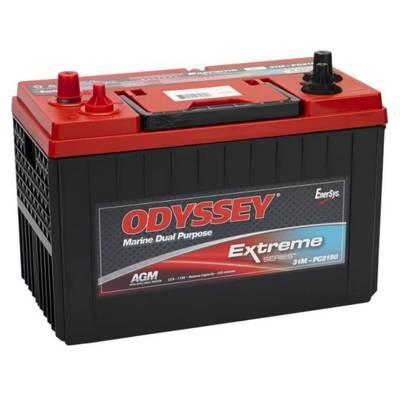
Odyssey 31M-PC2150ST-M Trolling Thunder Marine Dual Purpose Battery
Odyssey Thunder is a dual-purpose battery popular for its high capacity and mighty cranking power. The battery features an optimal gas recombination rate which is essential in ensuring that it does not dry out due to high power discharge.
The battery has a CCA of 925 amps in cold weather, and it goes up to 1150 in warm weather, with the voltage ranging from 14.4 -14.8. and it has a charging current of 25 amps.
The battery has a reserve capacity of 200 minutes with a high depth discharge rate. You can expect it to last 3 to 4 hours while powering a mid-size engine. Its high cycling performance ensures the boat remains steady even under extreme vibrations.
Features
- Measuring 13*6.8*9.9 inches
- Weight 75.2 lbs
- Lifespan 10 years
- 2-Year warranty
5. Optima YellowTopD27F Dual Purpose Battery
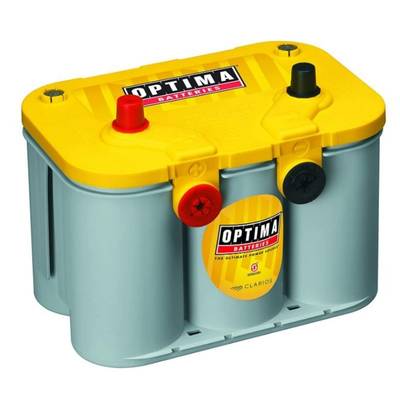
Optima YellowTopD27F Dual Purpose Battery
Optima YellowTop D27F Dual Purpose Battery is a dual-purpose battery that powers the battery and onboard appliance. It is the best cranking battery if your boat has heavy devices, including inverters, winches, and audio systems.
It has a mega cranking power of 830 amp during the cold season, and the cranking amps can go up to 1026. It releases 66 amps per hour at 12 volts. The battery design is made of a polypropylene case that makes it spill-proof, thus ensuring that it lasts long.
The battery design makes it easy to install and can be mounted on the boat in any position.
Features
- Weight 54 lbs
- Resistant to vibrations
- Fasting charging
- Low to no maintenance
- Its recharge and discharge cycles are above 300
Factors to Consider When Choosing the Best Boat Cranking Batteries
If you are looking to replace your boat's battery, you'll have a challenging time choosing the best cranking battery, as various brands are on the market.
However, you'll have an easy task with adequate knowledge of marine batteries and consulting with an expert. Use these factors when shopping for a marine battery for your boat.
Type
There are three types of marine batteries, and they include:
Marine Starting Battery
This battery is designed solely to power your boat's engine and provides quicks bursts of energy to propel your boat. And the best part is that the engine alternator recharges it.
However, if you need to power onboard appliances, you must procure another battery. Marine starting batteries cannot be used to power trolling engines and onboard devices.
Marine Deep Cycle Battery
These are ideal for big boats with trolling motors. Marine deep cycle batteries discharge power slowly over a long period, making them suitable for trolling motors and other onboard appliances, including winches, audio systems, fish locators, and depth finders.
You should never substitute deep cycle with starting batteries if you don't want to cause damage to your engine or be stuck in the middle of the lake when the battery dies.
Marine Dual-Purpose Battery
This can be used on deep cycling and cranking motors. They are most convenient when you don't have enough space to accommodate two different batteries.
However, marine dual-purpose batteries will not provide top-notch performance as they die faster than separate batteries.
Build
In the past, boat owners were using standard flooded cell batteries, which had a risk of spilling and not sufficient power. Technological advancements led to the development of new and improved sealed marine batteries that held more energy, were spill-proof, fast to recharge, and lighter in weight.
When buying based on the battery build, you can consider between:
Flooded Lead Acid
These are the cheapest batteries and have been around for decades. Our grandfathers and fathers used them in their cars and boats. The batteries are made of lead plates suspended in sulphuric acid, which helps in the storage and discharge of power. They can last for two or three years, depending on their maintenance.
You must check the sulphuric acid levels in the battery and top it up if it has evaporated. Dryness could damage your battery lead plates, lowering their performance levels and eventually becoming useless.
Absorbed Glass Mat (AGM)
This is the most common type of battery built on the market, and it uses acid and lead to store and release power.
However, the acid in AGM batteries is soaked into fiberglass mats, preventing it from sloshing or evaporating as the battery gets recharged. This makes them spill-proof, and they last longer than flooded cell batteries. Besides, they don't require any maintenance.
Lithium Ion Phosphate
These are the latest marine batteries, and they utilize lithium technology. They are better than flooded cells and AGM batteries as they have supercharging features, weigh much less, and outlive all the other batteries.
Due to their superior qualities, their cost is also ridiculous as they are about five times the standard batteries, but they are well worth the price.
Price
If you own a boat, you are privy to the high cost of its parts, and batteries are no exception. You must set aside enough cash to secure a top-quality marine battery as the price starts from hundreds of dollars. However, deep cycle batteries are the best if you use your boat often because they power it for long periods.
Do not opt for cheaper batteries as they don't have sufficient power to last long, and they will require frequent maintainance.
Weight and Size
The size and the weight of the marine battery depend on the boat. Small batteries are meant for boats of a small build, such as canoes and kayaks, and large boats require bigger marine batteries. So check how much room you have before your purchase.
The sizes of the marine boats are categorized into three:
- Groups size 24: This is suitable for small boats that don't require too much power. It is light in weight and has small dimensions.
- Group size 27: It is a medium-sized battery suitable for bass boats and can be used for both the deep-cycle trolling motor and dual-purpose starting batteries.
- Group size 31: It is large and suitable for large boats as it produces more power, is heavy, and takes up more space.
Voltage
The voltage rating is the first thing you should consider when choosing a marine battery for your boat. And like vehicles, boats use a 12V starting battery. It would be best to get a versatile battery that you can use on your motorhome and boat.
However, you must ensure that a 12V battery is the best for your boat, as some might require a higher or lower voltage. We've listed some powerful cranking and dual-purpose batteries in our list of best boat cranking batteries. So take a look.
Capacity
When buying marine batteries, you must check the capacity, as different batteries have varying performance levels. The capacity is listed as Ah, and it ranges from 45Ah and 50Ah, with some heavy-duty batteries having up to 125Ah.
The bigger the capacity, the longer the battery will last. For instance, if you don't use your boat often, it would be best o opt for a large capacity battery so that by the time you are using it again after months of rest, you'll find it in tip-top condition.
Cold-Cranking Amps
When buying a marine battery, some features to look out for are if it can be used during the cold season and how many Amps it releases. Some batteries cannot be operated in the winter, making it hard to explore the lake. If you have a long winter season and still want to go out on the lake, ensure that the battery has a sufficient amount of cold cranking amps.
Most marine batteries that can be operated in cold weather have a cold cranking Amp ranging between 500 and 1000 amps.
Battery Design
The battery design also plays a significant role in its placement and build quality. A battery with low heights makes it convenient to place it under the seats or any other small compartment.
The exterior covering of some batteries is rigid and made of corrosion, vibration, and impact-resistant materials, ensuring that they remain in place. The AGM batteries are also spill-proof, ensuring they last a long time and have low to zero maintenance.
Warranty
The period of warranty a manufacturer provides on their products determines the quality. Marine battery manufacturers offer warranties ranging from 3 to 5 years, a testament that they produce top-notch products.
Although the care and maintenance you provide to your battery play a crucial role in prolonging its lifespan, other factors include the type of the battery, the construction, and the design.
The level of maintainance and usage determines the length of time it will serve you, and when it fails, you have the warranty.
Tips for Maintaining Your Battery in Good Condition and Avoiding Problems
If you want your marine battery to serve for years to come without fail, use these tips.
Charging
If you live in warm regions, you already know that heat is the biggest enemy of marine batteries as it shortens their lifespan. On the other hand, the cold helps prolong their life expectancy. So, it's best to store your battery on a regulated "trickle" charger when it's not in use. This prevents damage from extreme weather, as it cracks because of being frozen.
Since a boat's battery is not as often as a vehicle's, it becomes weak quickly. It will signal you by not cranking up as usual or a dead battery warning. So make good use of the battery before that happens.
Replacing the Battery
If you notice that your battery is getting weak and not serving you as expected, it's time to replace it. Consult an expert when buying a new and best match for your boat. This can include amperes, cranking amps, reserve per minute capacity, and voltage. When shopping for starting batteries, focus on the cranking ability.
If you don't use your boat often, protect your battery using a maintenance charger that helps maintain its charge while in storage.
If your battery does not have a cover over the positive terminal, install one as it prevents sparks formation and explosion.
Before parking your boat during the offseason, ensure the battery is fully charged and disconnect the terminals to ensure no power discharge. If your storage warehouse has power, plug in the maintenance charger to ensure that it maintains its charge throughout the offseason.
You need to secure your marine battery using a good tray that is screwed onto the boat, ensuring it stays in place and does not knock against the sides of the boat.



